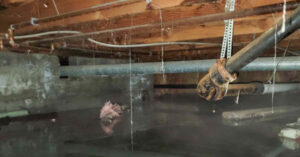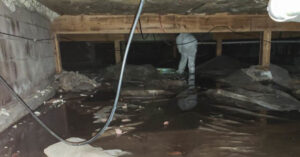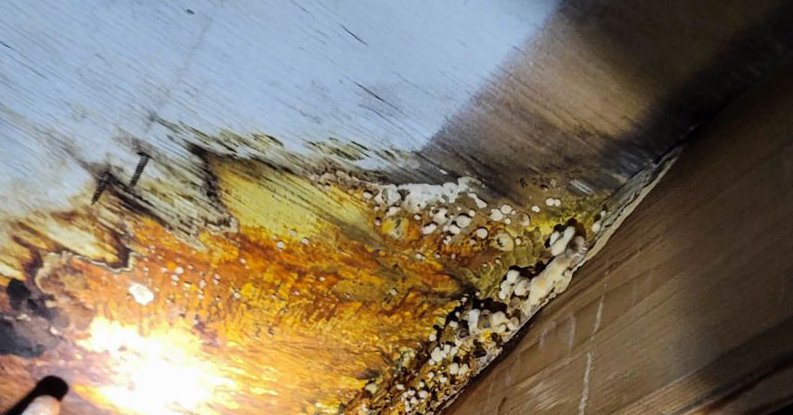Mold in crawl spaces is a common issue that homeowners face, with potential risks to both the structural integrity of the property and the health of its occupants. Understanding the causes, risks, and remediation of mold in crawl spaces is essential for preventing and addressing this problem effectively.
While some homeowners may choose to tackle the mold remediation of a crawl space themselves, professional mold remediation services are recommended. These experts have the necessary knowledge, experience, and equipment to safely and effectively address mold issues in crawl spaces. Their expertise in mold remediation ensures thorough removal and remediation, providing a mold-free and healthy living environment.
Causes of Mold in Crawl Space

In the dark and damp confines of crawl spaces, the growth of mold can be a persistent and troublesome issue. To understand the root causes behind this unwelcome presence, let’s turn our attention to the factors that contribute to mold in hidden spaces that would let you know if you have mold in your home.
1. High Humidity
Excessive humidity is a leading factor behind the development of mold in crawl spaces. The surplus moisture present in the atmosphere provides an ideal breeding ground for mold. To combat this issue, it is crucial to effectively manage humidity levels within the crawl space.
This objective can be accomplished through various techniques, such as the installation of a dehumidifier or enhancing ventilation. Conducting regular inspections of the crawl space plays a vital role in early detection of any moisture-related problems.
By addressing the problem of high humidity, homeowners can significantly diminish the likelihood of mold growth in their crawl spaces.
2. Water Leaks and Intrusion
Water leaks and intrusion are two major causes of mold growth in crawl spaces. When water infiltrates the crawl space through leaks in pipes, cracks in the foundation, or inadequate drainage, it creates a damp and humid environment that fosters the development of mold. Consequently, this can result in structural deterioration, health problems, and compromised indoor air quality.
Observable indications of water intrusion encompass dampness, water stains, and pooling. To prevent the growth of mold, it is absolutely essential to promptly address and rectify any instances of water leaks. This remedial action may entail knowing whether you need a vapor barrier or encapsulation, repairing plumbing issues, sealing cracks in the foundation, and enhancing the drainage system around the crawl space.
Conducting regular inspections can prove beneficial as they facilitate the early detection and mitigation of water leaks and intrusion.
3. Poor Ventilation
Poor ventilation in crawl spaces is a major contributor to the growth of mold. When there is limited air circulation, moisture from the ground tends to accumulate, creating a damp environment that is perfect for the development of mold. This, in turn, can lead to structural damage, compromised air quality, and various health issues.
To effectively prevent mold growth, it is crucial to enhance ventilation in crawl spaces. This can be achieved by installing appropriate vents or fans to facilitate proper air movement. Regular inspections and maintenance play a vital role in ensuring the ventilation systems are functioning efficiently.
In a distressing case, a homeowner failed to address the issue of poor ventilation in their crawl space, which resulted in significant mold growth. Consequently, this led to costly repairs and serious health problems for the family. However, after rectifying the ventilation problem, they wisely chose to hire professionals to remediate the mold issue. Moreover, they now prioritize regular inspections to prevent any future complications arising from inadequate ventilation.
Risks Associated with Mold in Crawl Space

Did you know that having mold in your crawl space can pose serious risks to both your home and your health? In this section, we’ll uncover the various risks associated with mold in crawl spaces.
1. Structural Damage
Mold in the crawl space can cause considerable structural damage to your home. As mold grows and spreads, it can weaken the foundation, walls, and support beams, leading to structural instability and putting the overall integrity of your home at risk. Over time, if left untreated, this can lead to sagging floors, unsightly cracks in walls, and even the potential collapse of your house in severe cases.
It is of utmost importance to promptly address mold in the crawl space to prevent any further structural damage and ensure the safety of your home and its occupants. Regular inspections, effective moisture control measures, and the assistance of professional mold remediation services are essential steps that must be taken to prevent and mitigate any potential structural damage that mold can cause.
By acting swiftly, you can safeguard your home from the detrimental effects that mold can have on its structural integrity.
2. Health Issues
Health issues are a significant concern associated with mold in crawl spaces. Mold exposure can result in various health problems, including allergies, respiratory issues, skin irritation, and mental confusion. Sneezing, coughing, and watery eyes are common symptoms caused by mold spores that can trigger allergic reactions in sensitive individuals.
Additionally, prolonged exposure to mold can exacerbate respiratory conditions like asthma. Skin irritation and mental confusion may also occur. To prevent these health issues, it is crucial to address the underlying causes of mold growth in crawl spaces and to seek professional mold remediation services when necessary.
Fun Fact: Mold can produce mycotoxins, which are toxic substances that can have harmful effects on human health.
3. Reduced Indoor Air Quality
Reduced indoor air quality is a significant risk associated with mold in the crawl space. Mold spores and volatile organic compounds (VOCs) released by mold can spread through the air, leading to poor air quality. This can cause respiratory issues, allergy symptoms, and skin irritation.
In some cases, individuals may experience mental confusion as well. To prevent a decline in indoor air quality, it is crucial to implement proper mold remediation measures. This includes identifying and fixing the source of moisture, removing mold-infested materials, and thorough cleaning and disinfecting of the affected area.
Additionally, encapsulation and waterproofing are effective strategies to prevent future mold growth and enhance indoor air quality.
Signs and Symptoms of Mold in Crawl Space
1. Musty Smells
Musty smells in the crawl space are a typical indication of the presence of mold. When moisture accumulates in the crawl space, it creates a damp environment that fosters the growth of mold. The mold emits volatile organic compounds (VOCs) that generate a musty odor.
Disregarding this unpleasant smell can result in further infestation of mold and potential health hazards. To effectively deal with musty smells in the crawl space, it is advisable to enlist the services of a professional mold remediation company.
They will identify and rectify the source of moisture, remove materials contaminated with mold, and thoroughly clean and disinfect the area to eliminate the odor and prevent future mold growth.
2. Allergy Symptoms
Allergy Symptoms can serve as a crucial indication of the presence of mold in crawl spaces. If you are consistently experiencing sneezing, itchy or watery eyes, nasal congestion, or respiratory problems, it could be a sign of allergies related to mold. Additional common allergic reactions may include skin irritation and mental confusion.
To effectively address these symptoms, it is imperative to identify and resolve the source of mold in crawl spaces. This process may entail addressing moisture issues, removing materials contaminated with mold, and implementing proper cleaning and disinfection procedures.
For optimal and safe mold removal, it is advisable to enlist the services of a professional mold remediation company that specializes in crawl spaces.
3. Respiratory Issues
Exposure to mold in crawl spaces can result in a range of respiratory issues. These respiratory issues can manifest as symptoms such as coughing, wheezing, shortness of breath, and throat irritation. Inhaling mold spores can also trigger allergic reactions and respiratory conditions, including asthma. The presence of mold in crawl spaces can significantly impact the health and well-being of individuals living in affected homes.
Therefore, it is crucial to address this issue effectively by identifying and resolving the source of moisture, removing materials infested with mold, and thoroughly cleaning and disinfecting the area. Engaging professional mold remediation services ensures a comprehensive and successful process for eliminating mold and reducing the associated respiratory risks.
4. Skin Irritation
Skin irritation is a typical indication that mold is present in crawl spaces. When the skin comes into contact with mold spores, it can lead to rashes, itching, and redness. To effectively address skin irritation, it is crucial to tackle the underlying mold problem. This involves identifying and fixing the source of moisture, removing materials that are infested with mold, and thoroughly cleaning and disinfecting the affected area.
Additionally, encapsulation and waterproofing methods can be employed to prevent future mold growth. If skin irritation persists, it is advisable to seek the assistance of professional mold remediation services. These trained professionals can ensure the proper removal and remediation techniques, minimizing any potential health risks and ensuring a safe and healthy environment.
5. Mental Confusion
Experiencing mental confusion can be an indication of the presence of mold in the crawl space. Mold releases spores into the air, which can have an impact on cognitive function when inhaled. It can result in difficulties with concentration, memory issues, and a sensation of mental fog.
If you identify these symptoms, it is crucial to address the mold problem in your crawl space. Seeking the assistance of professional mold remediation services can effectively eliminate the mold and enhance the quality of indoor air. This, in turn, reduces the risk of mental confusion and other health problems associated with exposure to mold.
Professional Mold Remediation Services

When it comes to dealing with mold in your crawl space, calling in the professionals is a game-changer. From the importance of hiring a trained expert to the benefits of professional mold remediation services, and even tips on choosing the right company, this section will guide you through the world of professional mold remediation. Say goodbye to mold-related risks and hello to a safe and healthy living environment. It’s time to take control and let the experts handle it!
Importance of Hiring a Trained Professional
Hiring a trained professional is of utmost importance when dealing with mold in the crawl space. Here are some reasons why it is crucial:
- Expertise: Trained professionals possess the necessary knowledge and experience to accurately assess the severity of the mold problem and devise the most effective remediation approach.
- Safety: Mold removal can pose a hazard due to the handling of potentially toxic substances. Trained professionals are equipped with the required equipment and follow proper protocols to ensure their safety as well as the safety of the individuals residing in the property.
- Efficiency: Professionals are equipped with the right tools and resources to efficiently and effectively eliminate mold, thereby minimizing the risk of its recurrence.
- Prevention: Trained professionals can identify underlying issues contributing to mold growth and offer recommendations on how to prevent future mold problems. This saves you time, money, and potential health issues.
If you have mold in your crawl space, it is strongly recommended to entrust the job to trained professionals. Hiring a trained professional will guarantee a thorough and safe mold remediation process, providing you with peace of mind.
Benefits of Professional Mold Remediation Services
- One of the benefits of professional mold remediation services is the expertise they provide. Trained professionals have the necessary knowledge and experience to effectively identify and address mold issues.
- These professionals also conduct thorough inspections to locate the source of moisture and determine the extent of mold growth, which is another advantage of using their services.
- Safe removal of mold-infested materials is a priority for professional mold remediation services. They follow proper procedures to minimize the risk of cross-contamination.
- Effective remediation is another benefit of hiring professionals. They utilize specialized equipment and techniques to ensure complete mold removal and to prevent future growth.
- Not only do these professionals handle the mold problem at hand, but they also provide recommendations on preventing mold recurrence. Measures such as improved ventilation and moisture control can be suggested.
- Utilizing professional mold remediation services can result in time and cost savings. Compared to DIY attempts, professionals work efficiently and have access to the necessary tools and resources.
Frequently Asked Questions about Mold in Crawl Space
How many species of mold exist in the United States?
Over 1,000 species of mold exist in the United States, some of which are invisible to the naked eye.
What are the signs of mold growth in a crawl space?
Musty smells are often a sign of mold growth in a crawl space. However, mold can be difficult to eliminate even with cleaning.
What are the symptoms of mold allergies?
Mold allergies can cause symptoms similar to an upper respiratory infection, including a stuffy or runny nose, sneezing, coughing, itchy eyes, and skin irritation.
How can mold damage the home?
Mold can damage organic materials in the home, such as wood, paper, fabrics, and glue. This can lead to deterioration and potential collapse of ceilings, floors, and walls.
Can mold in the crawl space affect the HVAC system?
Yes, mold in the crawl space can spread to the HVAC system. Once contaminated, the HVAC system can distribute mold spores throughout the rest of the home.
What are the symptoms of toxic mold syndrome?
Exposure to toxic forms of mold can result in toxic mold syndrome, which includes symptoms such as mental confusion, memory loss, insomnia, and anxiety.



